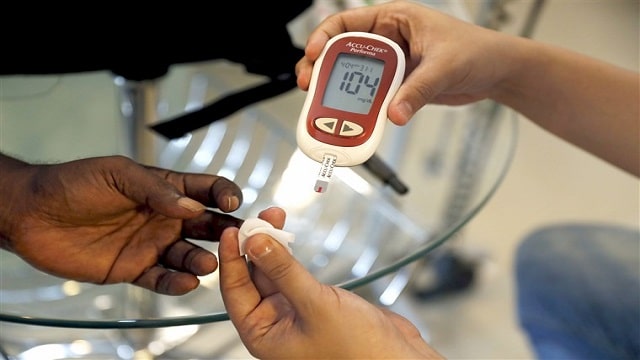Fasting Glucose Check
A fasting glucose test is a test to measure a person’s blood sugar after fasting overnight. A fasting blood sugar level of 99 mg/dL or lower is normal, 100-125 mg/dL indicates you have prediabetes, and 126 mg/dL or higher indicates you have diabetes.
High fasting blood sugar levels indicate insulin resistance or diabetes. Low fasting blood sugar levels can be caused by taking diabetes medication or other factors.
Glucose is a simple sugar that is the body’s main source of energy. The body converts carbohydrates that are eaten into glucose. Fasting glucose tests are often done for people with prediabetes, type 1 diabetes, type 2 diabetes, and gestational diabetes. Diabetes is a condition that causes blood glucose levels to rise. The amount of sugar in the blood is normally controlled by a hormone called insulin.
However, if you have diabetes, your body doesn’t produce enough insulin or the insulin it produces doesn’t work properly. This causes sugar to build up in your blood. High blood sugar levels can lead to serious organ damage if left untreated.
In some cases, a blood glucose test can also be used to check for hypoglycemia, which occurs when blood glucose levels are too low.
When Should You Do a Fasting Glucose Check?
Prediabetes, type 2 diabetes, and gestational diabetes often have no symptoms at first. A person can have the condition and not know it. Well, a fasting glucose test can help detect these conditions. Doctors will usually recommend a fasting glucose test:
- As part of a standard annual physical exam to monitor a person’s blood glucose over time.
- For pregnant women to ensure that pregnancy hormones do not cause diabetes.
- When a person has symptoms of diabetes, a family history of diabetes or risk factors for diabetes (such as obesity).
- When a person has previously had blood glucose levels that are higher than normal.
Why Do a Fasting Glucose Test?
Fasting glucose testing is an easy, safe, and common way to diagnose prediabetes, diabetes, or gestational diabetes. It is also used to test the effectiveness of various medications or dietary changes in people who have been diagnosed with diabetes. When fasting, the hormone glucagon is stimulated, increasing plasma glucose levels in the body.
If a person does not have diabetes, their body will produce insulin to rebalance the increased glucose levels. However, people with diabetes do not produce enough insulin to rebalance their blood sugar (such as in people with type 1 diabetes), or their body cannot use insulin effectively enough (such as in people with type 2 diabetes).
As a result, when blood glucose levels are tested, people with diabetes have higher blood sugar levels than those without diabetes.
How to Do a Fasting Glucose Check?
People who want to do a fasting glucose test should not eat or drink anything except water for eight hours before the test. Usually, the recommended time to do a fasting glucose test is in the morning so that you don’t have to fast during the day.
Before taking the test, you need to inform your doctor about the medications you are taking. This includes prescription drugs, over-the-counter drugs, and herbal supplements. Certain medications can affect blood glucose levels. Your doctor may ask you to stop taking certain medications or change the dosage before the test.
Fasting blood glucose checks are usually done by taking regular blood. Here are the things that health workers or doctors will do during the examination:
- Clean the inside of the elbow to kill germs.
- Tying a ribbon or string around the upper arm to fill the veins in the arm with blood.
- A clean needle is inserted into a vein, and blood is drawn into a tube attached to the needle. The tube is labeled with the patient’s personal information.
- Remove the tape and then the needle.
- Press the injection area with clean cotton to stop the bleeding, then a bandage will be attached to the area.
After taking blood, the health worker will send the blood sample to a laboratory for testing.
In some cases, a healthcare provider may check a patient’s blood sugar with a finger prick instead of a needle in a vein. A provider uses a blood glucose monitor and test strips to measure a patient’s blood glucose level in the doctor’s office.
Where to Do Fasting Glucose Check?
Fasting glucose checks can be done at public hospitals or trusted health laboratories. One way to keep blood sugar stable is to take prescribed medication regularly, which you can buy all through the Halodoc service. No need to leave the house, just order through the application and your order will be delivered within an hour.

